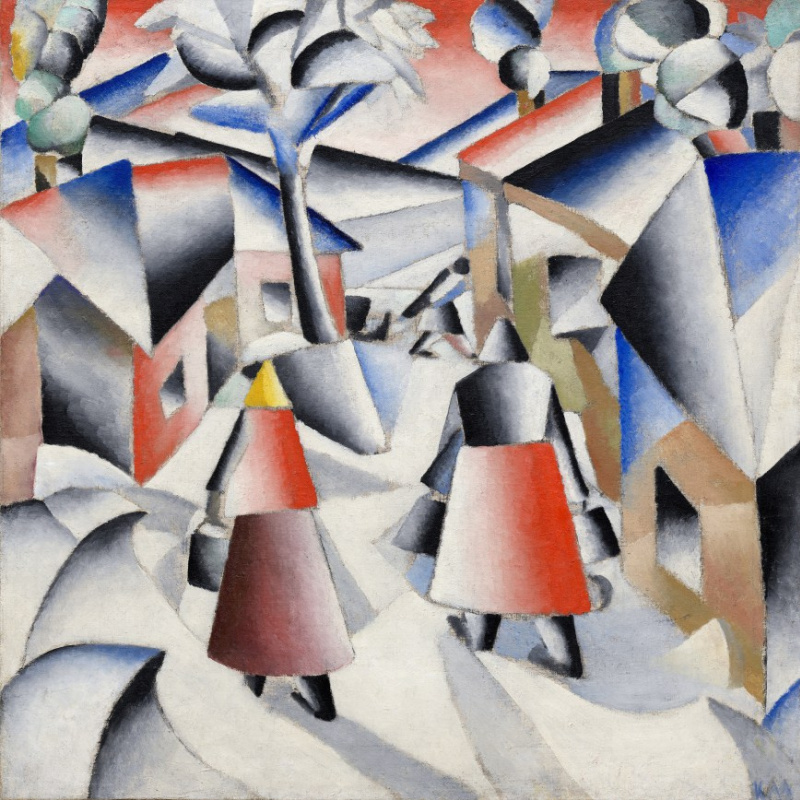log in
Enter site
Login to use Arthive functionality to the maximum
The morning after a blizzard in the village
Kazimir Malevich • Painting, 1912, 80×80 cm
Description of the artwork «The morning after a blizzard in the village»
In 1927 Kazimir Malevich brought some tens of his paintings to the Great Berlin Art Exhibition where he was provided with an individual room for his works. Among his artworks was the “The morning after a blizzard in the village”, the canvas Malevich managed to sell for the unthinkable for him amount of money which made 2,000 roubles. After this exhibition Malevich found himself famous, though his trip over Europe with flying colors did not happened; suddenly he was ordered to return to his country.
According to art experts three artists inspired Malevich for creation of the painting. One of them was Camille Pissarro and a cycle of his artworks dedicated to trees and meadows in Eragny at different time and different seasons (“ orning Sunlight on the Snow. Eragny-sur-Epte”, 1895, in particular). The other artist was Fernand Leger, early cubistic artworks by whom Malevich could see at the exhibition in Moscow in 1912. And at last we cannot but mention the influence of Paul Cezanne, whom Malevich called his only teacher and mastermind.
The artworks of Malevich are rarely considered from the point of view of the social or political context. Though among the artists of Malevich’s times there was enough number of those involved in politics much more than Malevich. However, even in such simple subject the experts virtually recognized prophesy. Some researchers think that the fact that Malevich so often painted peasants at the eve of the Revolution was not occasional. They also found the roots coming into the artist’s childhood in the “The morning after a blizzard in the village”. The years spent by the artist in small towns (like Konotop, in particular) are regarded to have significant influence on his further oeuvre: lively recollections of his childhood assisted the artist in mastering his skills and compensated the lack of professional training.
In 1913 soon after the painting had been created, the art critic and expert Yakov Tugendheld offered his own “nationalist” concept: «Amusing joining of futurism and nationalism of Malevich: as a patriot he paints the world with the color of national banner and as a futurist he presents it in the shapes of steam boilers and cylinders and locks poor Russian males and females into a glittering armor of industry”.
Written by Eugeniya Sydelnykova
According to art experts three artists inspired Malevich for creation of the painting. One of them was Camille Pissarro and a cycle of his artworks dedicated to trees and meadows in Eragny at different time and different seasons (“ orning Sunlight on the Snow. Eragny-sur-Epte”, 1895, in particular). The other artist was Fernand Leger, early cubistic artworks by whom Malevich could see at the exhibition in Moscow in 1912. And at last we cannot but mention the influence of Paul Cezanne, whom Malevich called his only teacher and mastermind.
The artworks of Malevich are rarely considered from the point of view of the social or political context. Though among the artists of Malevich’s times there was enough number of those involved in politics much more than Malevich. However, even in such simple subject the experts virtually recognized prophesy. Some researchers think that the fact that Malevich so often painted peasants at the eve of the Revolution was not occasional. They also found the roots coming into the artist’s childhood in the “The morning after a blizzard in the village”. The years spent by the artist in small towns (like Konotop, in particular) are regarded to have significant influence on his further oeuvre: lively recollections of his childhood assisted the artist in mastering his skills and compensated the lack of professional training.
In 1913 soon after the painting had been created, the art critic and expert Yakov Tugendheld offered his own “nationalist” concept: «Amusing joining of futurism and nationalism of Malevich: as a patriot he paints the world with the color of national banner and as a futurist he presents it in the shapes of steam boilers and cylinders and locks poor Russian males and females into a glittering armor of industry”.
Written by Eugeniya Sydelnykova


